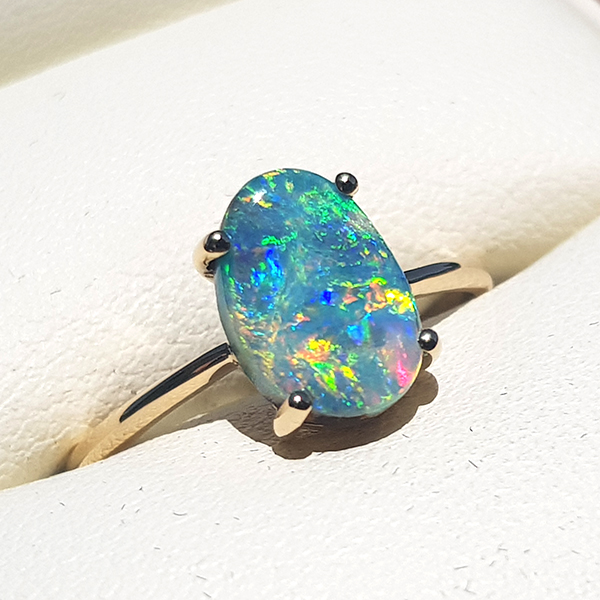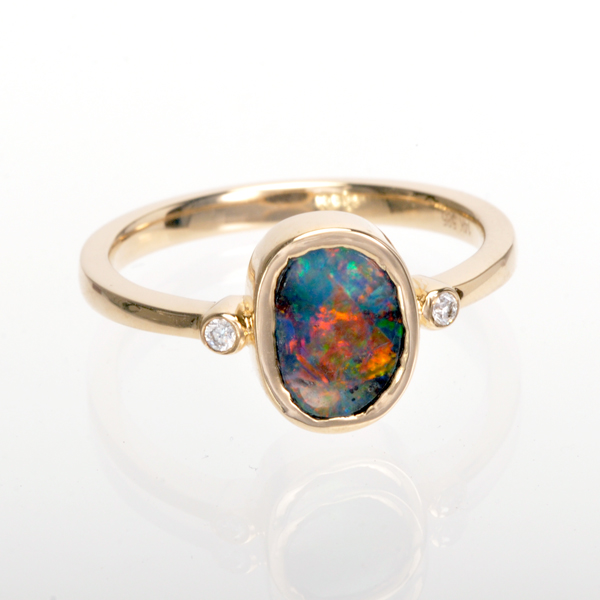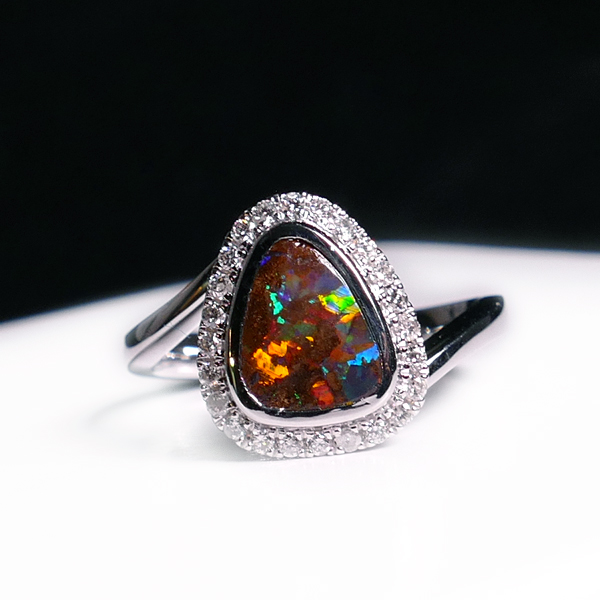Finding the perfect Queensland boulder opal engagement ring...
Proposing with a Queensland boulder opal engagement ring is an excellent choice. Here at the Brisbane Opal Museum we LOVE Queensland boulder opal. Boulder opal is a very unique type of opal stone that is found in the most remote outback areas of Queensland. Some of the opal fields are at Yowah, Quilpie, and Winton. Boulder opal occurs when silica solution enters empty voids in ironstone boulders, and then, over thousands of years, forms itself into the play-of-colour that opal is famous for. The unique way that the solution flows and seeps through the ironstone creates patterns that you will not find in any other opal. An interesting fact about boulder opal is that, in the old days, it used to be called "Barcoo Opal", nicknamed after a river that flows through the outback.
 Queensland Boulder Opal Engagement Ring in Yellow Gold
Queensland Boulder Opal Engagement Ring in Yellow GoldWhen we cut the Queensland boulder opal, we leave it naturally attached to its host ironstone. This is one of the greatest things about boulder opal: it cannot be made synthetically. If you were to glue a seam of opal onto a slab of ironstone, the glue would eventually bubble and separate from the stone. When an opal is glued onto a dark backing, it is called a doublet. You can read about these "enhanced" opals here.
It cannot be stressed enough how important it is that Queensland boulder opal cannot be made synthetically. With not only opals but all types of gemstones it is becoming increasingly difficult to tell a fake or an enhanced gemstone from a natural one. At the turn of the 19th century, pearls were more valuable than diamonds. However, once they patented cultured pearls, their value plummeted.
It's like comparing a famous piece of artwork to a reproduced print. Nothing copied will ever be as good as the real thing! On this page we will explain why a (solid) boulder opal engagement ring is the best possible choice to wow her, and most importantly... make her say "YES!"
Picking a compelling stone for a Queensland boulder opal engagement ring
There are different types of Queensland boulder opal: clean faced, matrix, and Yowah nuts. For the perfect boulder opal engagement ring you will want a clean faced boulder opal. Clean faced Queensland boulder opal is when there is no (or very little) ironstone intermixed with the layer of precious opal. There are two distinct layers: one ironestone, one opal.
 Queensland Boulder Opal Engagement Ring in Yellow Gold with Diamonds
Queensland Boulder Opal Engagement Ring in Yellow Gold with DiamondsThe Queensland boulder opal also needs to be compelling. There are three key features that make an opal compelling: brightness, pattern, and colour. Boulder opals can have very bright, brilliant flashes of colour in swirls of bold patterns that are enhanced by the darkness of the boulder layer. Because of this, many boulder opals will have a similar effect to black opals. Boulder opals are my absolute favourite opal (and I've seen tens of thousands of opals), and if I had $50,000 to buy ONE opal it would be a Queensland boulder opal, not a black opal. In the shop, we will have customers come in asking for a black opal at first, but they end up falling in love with a boulder opal instead. Be warned though: these days it is very hard to get a top quality boulder opal for a ring. They are just not digging much out of the ground because it is too expensive to mine.
Characteristics of a Queensland boulder opal engagement ring
Queensland boulder opals are usually cut into organic shapes following the curves of the stone. Because of the thinness of the opal layer, it's likely that the surface of the boulder opal won't have a dome shaped top like most classic solid opals. The surface of the boulder opal will either be an undulating or wavy layer of precious opal. Another thing to keep in mind is that Queensland boulder opal engagement rings are usually placed in a rub-over setting (metal surrounds the stone - read more about it here). The opal will be exquisitely displayed and protected by a halo of gold, while the ironstone layer will show through at the base of the ring.
 Queensland Boulder Opal Engagement Ring in White Gold with a Rub-Over Setting and Diamond Halo
Queensland Boulder Opal Engagement Ring in White Gold with a Rub-Over Setting and Diamond HaloNow that you've read all about boulder opals we hope that you find them as great a choice for an engagement ring as we do. If you'd like to see more examples of compelling Queensland boulder opal rings visit us in person or at our online shop.